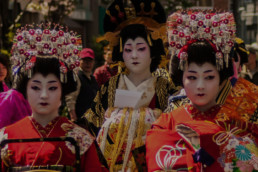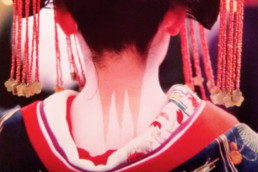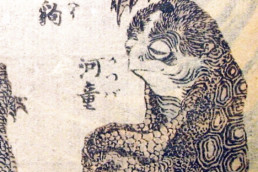Japan Folklore: Miko
Miko (巫女)
"The Shrine Maiden"
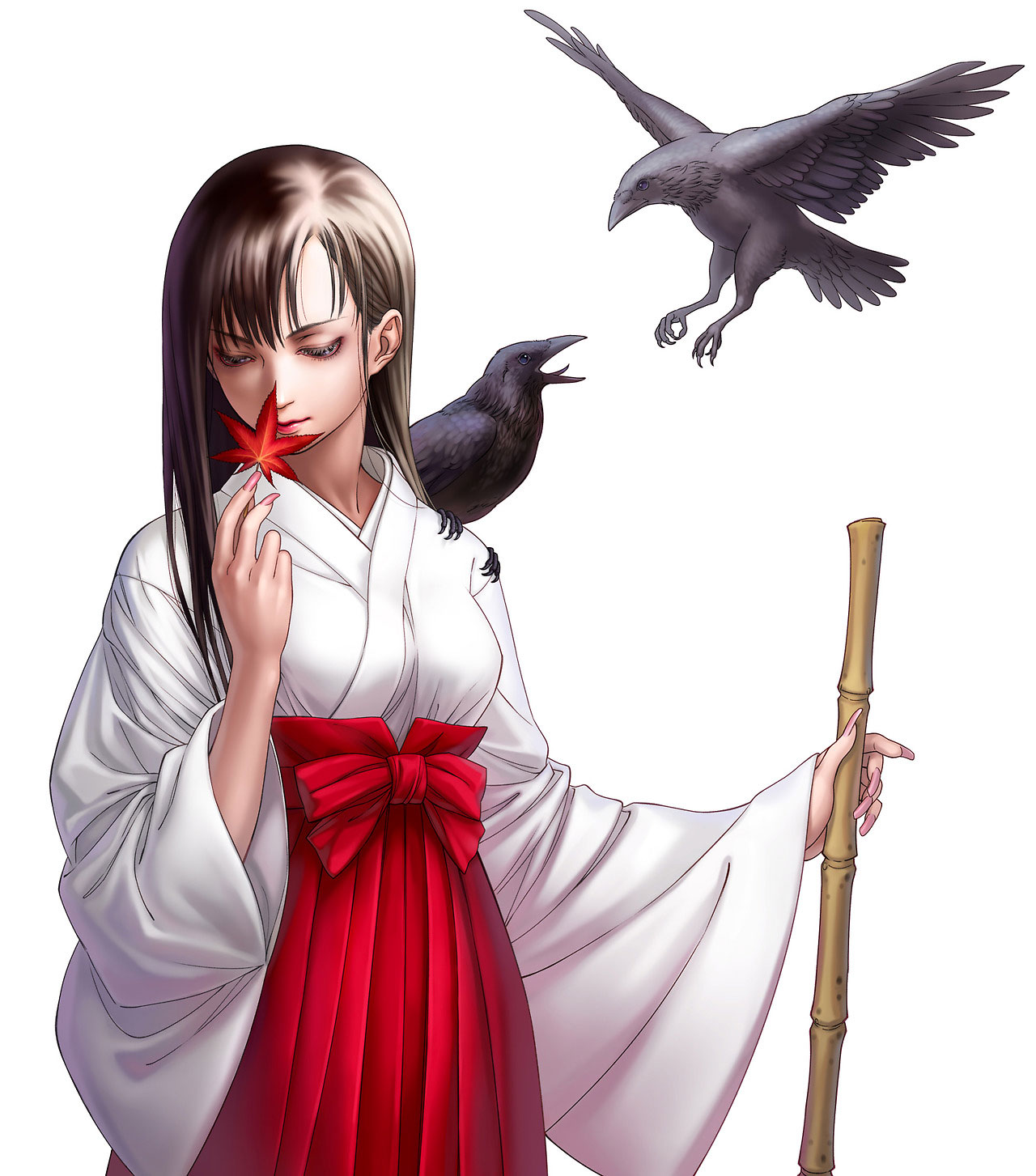
Photo credits: pinterest.com
We have seen them in many different anime: Rei Hino, the brave Sailor Mars from Bishōjo senshi Sērā Mūn, the mysterious Kikyō from Inuyasha, or the cheerful Hiiragi twins from Lucky Star.
All these characters shared the same occupation: they were miko, girls that serve as helpers in Shinto temples managing various functions. In fact, we find miko committed to helping the priest in his functions, they keep the temple clean and collect the offerings of worshippers.
Defining this figure by Western standards in very difficult. Miko are not comparable to Christian nun, nor are they actual Priests, even though in Shinto women are allowed to become priests. They are more similar to the oracles of ancient Greece, or to shamans, as in ancient times they were gifted with the possibility to talk with the kami, Shinto deities. By entering a state of trance, they could intercede with the gods and then communicate their will to the humans. These divinatory gifts and their ability to communicate with the world of the spirits were recognized as Divine will.
The origins

Photo credits: dannychoo.com
Their origin dates back to the Jōmon period, the Japanese Prehistory, which goes from around 10,000 BC. up to 300 AD. One of the earliest record of anything resembling the word ‘miko’ can be found in the name of the Shaman queen Himiko (c. 175 - 248). She was the ruler of the Yamatai, the most powerful among the kingdoms in which archaic Japan was divided. But we do not know if Himiko was a miko or not.
The word ‘miko’ is made of the kanji 巫 "shaman, unmarried virgin", and 女 "woman", and it is generally translated as ‘Shrine maiden’. An archaic form of the word is 神子 “Divine child”.
Their strong connection with the deities is also testified by the fact that miko danced the kagura (神楽), literaly "god-entertainment” or “music for the gods". This is an ancient Shinto dance rooted in Japanese folklore that links to the goddess of dawn, Ama-no-Uzume. It is said that with this dance the goddess managed to convince Amaterasu, the goddess of sun, to leave the cave where she was hiding after quarreling with her brother Susanoo, the god of the storm.
The kagura dance was often presented at the imperial court by those miko who were in fact seen as the descendants of Ama-no-Uzume.
In ancient times, miko were considered essential social figures, and this role meant great commitment and responsibility. Their divine bond identified them as messengers of the will of the kami, but not only this. It also placed them in the position to influence the social and political life, and therefore the fate of the village where they served.
However, they underwent a considerable crisis starting mainly from the Kamakura period (1118-1333). In fact, there were attempts to try to take hold of their shamanic practices, and miko, without anymore funds, were forced into a state of mendicancy. Some of them sadly fell into prostitution.
After a period of great transformations during the Edo period, in 1873, the Religious Affairs Department (教部) issued an edict called Miko Kindanrei (巫女禁断令). It prohibited all spiritual practices of young miko.
How to become a miko

Photo credits: thirteensatlas.wordpress.com
The path to become miko was long and difficult. Chosen by the clan on the basis of her spiritual strength, or because she wa a direct descent of a shaman, the girl began her preparation at a young age, usually with the first menstruation. It took three to seven years to become a full-fledged miko.
The girls would wash in cold water, practice abstinence, and perform other purification acts. Everything was aimed at learning how to control their state of trance.
They learned a secret language only known to shamans, and they also needed to learn the names of all the kami relevant to their village. They also learned the divinatory art of fortune-telling and the dances they needed to perform in order to enter the state of trance necessary to talk with the deity.
At the completion of this training there was a ceremony that symbolized the marriage between the miko and the kami she would serve. Dressed in a white robe that represented her previous life, the girl entered a state of trance and was asked which kami would she serve. After that, a rice cake was thrown at her face causing her to faint and she was laid down in a warm bed until she woke up. Then, she would wear a colorful kimono symbolizing her marriage with the deity .
Due to this bond with the deity, young girls had to remain virgin. Still, there were cases of miko with a particularly strong spiritual power that continued their service even after marriage.
Miko today

Photo credits: muza-chan.net
Nowadays the figure of miko still exists but they are mostly young university girls who work part-time at the temple. They assist the kannushi or 'man of god' in the various functions and rites of the temple, perform ceremonial dances, keep the temple clean and sell omikuji, sheets of paper on which is written a divine prediction. They generally do not need any specific preparation and do not necessarily need to be virgins, though they are still required to be unmarried. The kagura dance has become a mere ceremonial dance and it is no longer a way of coming into contact with the divine entity.
Their traditional outfit consists of a white haori representing their pureness, for the upper part of the body, and a pair of red hakama. Red or white are the ribbons in their hair.
During the ceremonies they use bells, sakaki branches, or offer prayers playing a drum. Among other ritual objects there is also the azusa-yumi, a bow that was once used to ward off evil spirits. In the past they also used mirrors to attract the kami and katana.
Maybe miko have lost their divine bond, but they still retain the millenary tradition of taking care of the temple, remaining one the most famous figures of modern Japan.

Photo credits: pinterest.com
Japan Folklore: Botan Dōrō
Botan Dōrō
The Peony Lantern
 Photo credits: allabout-japan.com
Photo credits: allabout-japan.com
There are many stories where unlucky lovers are separated by destiny that sometimes leads them to death together (Romeo and Juliet and Tristan and Isolde are the most famous). But none is like the story Botan Dōrō or The Peony lantern (牡丹 燈籠). Two lovers, divided by the world of the living and the world of the dead, are inextricably bounded by their oath of eternal love.
This legend sees the light in the book Jiandeng Xinhua written by Qu You during the first part of the Ming dynasty. Subsequently, it was revived during the Edo period by the Buddhist writer and priest Asai Ryōi on the wave of the Kaidan phenomenon (怪 談). This Japanese term refers to all those stories that tell of mystery and ghosts, written with two kanji: Kai (怪) that means "strange, mysterious, enchanted appearance" and Dan (談) "recited narration".
This legend is recognized as one of the first Japanese stories about ghosts to become a movie in 1910. With numerous re-editions over the years, it is perhaps the most productive one among cinema, television adaptations and Pink Movie, Japanese Soft Porno genre.
The beautiful Otsuyu
 Photo credits: pinterest.com
Photo credits: pinterest.com
The legend says that during the first night of the Obon (the commemoration of the dead according to the Japanese Buddhist tradition) the samurai Ogiwara Shinnojo meets a beautiful woman and her child servant. The two hold in their hands the traditional lanterns of peonies and the samurai asks the child the name of the beautiful woman. Otsuyu was her name and the samurai is not able to do anything but fall madly in love and swear his eternal love for her that same night. From then on, the two meet every night burning with passion for each other. However, the beautiful woman and the child would always disappear before dawn. Because of this strange behavior, and also because of a sudden illness of the man, an old neighbor gets suspicious. Entering his house, he discovers that the samurai was not laying in bed with a beautiful woman but with a skeleton! The old neighbor then speaks with a priest who in turn warns Ogiwara that discovers that his beloved is actually a ghost. Ogiwara also understands that his illness is due to the fact that sleeping with a spirit consumes the vital energy of a person. The priest blesses the house of the samurai leaving protective spells and good luck charms so that the woman and the child cannot enter it anymore. The same evening the woman tries in vain to reach her beloved but, failing, desperately screams her love for Ogiwara, that eventually yields letting her enter the house. The next morning, the neighbor and the priest find Ogiwara dead clutching the skeleton of Otsuyu.
From the horror style of the Edo period to the romanticism of the Meiji period.
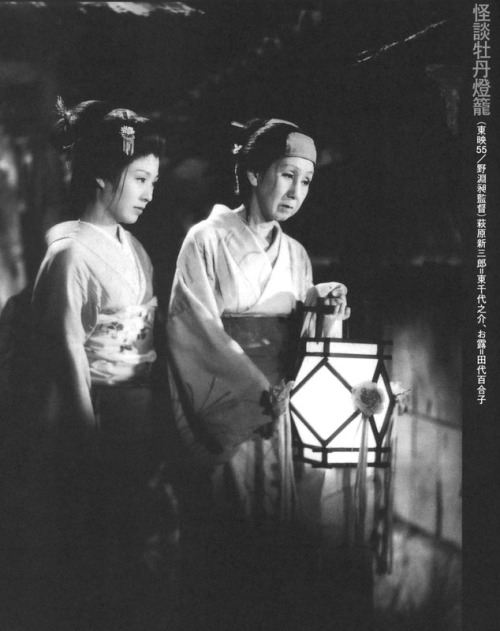 Photo credits: tumblr.com
Photo credits: tumblr.com
The Kabuki version of this story is very famous, but there is a substantial difference between the two. In the theatrical versions, in fact, the protagonists know each other before the death of Otsuyu. Their families have been close for a long time and this had encouraged the birth of love between them. This version is the perhaps the most renowned one as it is pregnant with romance from beginning to end. Their love, the youthful passion, and then the frustration for a forced separation cause by the boy's illness. During this period of separation Otsuyu dies believing that Saburo had not survived. But Saburo recovers and, desperate for the death of the girl prays to her spirit during the Obon festival. That same evening, he meets on his way home a woman and her servant holding a lantern of peonies. To his great joy, the young man realizes that the woman is his Otsuyu who, from that night on, will go visit him every night. But their joy will not last long. In fact, a servant, spying from a crack in the wall of Saburo's room, realizes that in reality he lies every night with a skeleton. A Buddhist priest is immediately called and talismans are attached to the door of the house to prevent the spirit from entering. Yet, every night the girl returns to cry out her love for Saburo, who, desperate for the new separation, falls ill again. But the awareness of loving her anyway and despite everything means only one thing. Death! The talismans are removed to allow the spirit to enter once again. For the last time. However, the young protagonist dies happily in the arms of the one he loves.
This difference of themes can be attributed to the different periods in which the two versions were written. The original one dates back to the Edo period with the macabre vein that characterizes the Japanese folklore of the time. The theatrical one is more recent and sees the light in the Meiji period, the period in which Japan approaches the West thanks to the opening of Emperor Mutsuhito. Opening that did not occur only on a political level, but also on a cultural level thus influencing tastes and customs, and this legend is an example.[:]
Japanese Culture: Ramen
Ramen: “The emperor” of Japanese cuisine.

Photo credits: narutonoodle.com/
Until a few years ago, for ethnic cuisine enthusiasts, going to a Japanese restaurant strictly referred to taste Sushi: a dish made of raw fish and rice.
This dish, with its colorful and evocative shapes, winks at the most fashionable diners (but not just them!), who have the opportunity to taste "first with their eyes than with their mouth". But now another famous dish in Japan has finally made its way to our tables, with many people going crazy about it.
We are talking about Ramen (ラーメン,拉麺 rāmen), perhaps the real representative dish of the country, and so famous throughout Japan that each region boasts a different way to prepare it. Different region, different recipe. Let’s taste them all then...
A soup with many ingredients: Chinese noodles, pork, Nori (海苔) or dried seaweed, boiled eggs, and the kamaboko. Mainly known as surimi. Its most famous form, the spiral one, is called Naruto (like the manga character of the same name whose name derives from this ingredient). It can have fish or meat broth, various garnishes and different ways to flavor it, with sesame seeds or pepper for example, miso or soy sauce.
Story of a Soup

Photo credits: travelcaffeine.com
Although it is unclear when the spread of this plate began in Japan, the origin is Chinese as one of its main ingredients are the Chinese mian or Chinese wheat noodles. But we must say that only in recent years there has been a revival in China, as ramen is no longer considered a traditional dish but a Japanese imported product. In China, they are called rìshì lāmiàn or "Japanese style Lamian".
Ramen has always been a dish to be enjoyed outside and at the beginning of the 20th century there were numerous kiosks with Chinese handlers. Then, after the Second World War, Japanese soldiers returning from China, where they had learned this culinary tradition, opened several restaurants across the country. From that point on, there has been an evolution that led to ramen as we know it today.
It is so appreciated that in 1994 the Shin-Yokohama Raumen Museum entirely dedicated to this delicacy was opened in Yokohama .
‘Company’ Ramen.
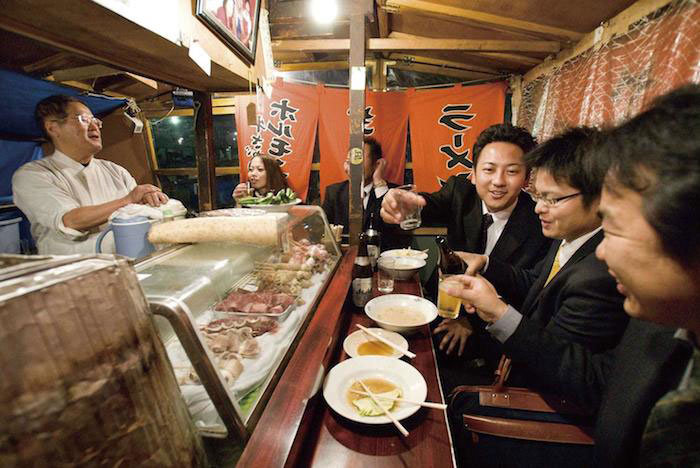
Photo credits: jpninfo.com
As previously mentioned, in the past it was not so strange to taste ramen bowls in street stalls, which are still popular today, though not so very widespread. This is because ramen is also considered a street food to be enjoyed in traditional Yatais or stalls. On the other hand, the best restaurants are the Ramen-ya with just a few seats at the counter and at the tables as well, but with the purpose of eating ramen only. And it is not unusual to find ramen in amusement parks or in karaoke's menus. It may also happen that after work colleagues stop by an Izakaya, a pub with the formula Nomihodai "all you can drink" - Tabehodai "all you can eat". Here, with a limit of three hours, diners can enjoy ramen together with liquor and other foods with fixed-price menu.
Honorable mention and regional variants

Photo credits: zerochan.net
Although the classic recipe is common throughout Japan there are always innovative variants.
Here we have to mention the Blue Ramen, of a beautiful and brilliant color, and we want to specifie this, it is completely natural! But this is an extreme innovation.
“Traditional” regional variants are:
- Tokyo variant, with thick noodles, chicken and soy broth, garnished with bamboo shoots, shallots, sliced pork, seaweed, spinach, an egg and a little bit of Dashi. We recommend you try shops in Ikebukuro, Ogikubo and Ebisu wards.
- Sapporo is famous for the "winter" version, sometimes garnished with seafood, butter, pork, corn and bean sprouts.
- Yokohama has the le-kei , coddled eggs for which each customer can choose the desired softness and then break it so to flavor the broth, also adding onion, pork, spinach and seaweed.
- Kitakata with its thick but flat noodles served with pork broth.
- Hakata and its broth made of pork bones, thin noodles, ginger, vegetables, mustard and sesame seeds.
If reading this article made you really hungry we want to recommend some places where you can taste ramen in Italy:
Nozomi
Via Pietro Calvi 2, 20129 Milano, Italia
+39 02 7602 3197
http://www.nozomi.milano.it/
Casa Ramen
Via Porro Lambertenghi 25, Milano, Italia
+39 02 3944 4560
https://www.facebook.com/casaramen
Zarà Ramen
Via Solferino, 48, 20121 Milano, Italia
+39 02 3679 9000
https://www.facebook.com/zazaramen/
Mi-Ramen Bistro
Viale col di lana, 15 | Viale Col Di Lana, 15, 20136, Milano
+39 339 232 2656
http://mi-ramenbistro.it/
Osaka
Corso Giuseppe Garibaldi 68, 20121 Milano, Italia
+39 02 2906 0678
http://www.milanoosaka.com/
Ryukishin
Via Ariberto 1, 20123 Milano, Italia
+39 02 8940 8866
http://www.ryukishin.it/
Banki Ramen
Via Dei Banchi 14 Rosso, 50123, Firenze, Italia
+39 055 213776
Waraku
Via Prenestina 321/A, 00177 Roma, Italia
+39 06 2170 2358
https://www.facebook.com/Waraku-192626757583758/
Japanese Folklore: The Ring
Ringu: The cursed tape

Photo credits: Movieweb.com
The Ring is the fortunate American horror movie with Naomi Watson in the role of the protagonist that in 2002 haunted cinemas all around the world. Earning more than $250 million dollars at the box-office it revived a suffering genre giving the bravest spectators shivers. The movie had a sequel, The Ring 2 out in 2005, and The Ring 3 recently came out, fifteen years after the original movie.
Samara Morgan is a little girl with long raven hair and snow-white skin, and from this description she might appear like a pure Snow White. But reality is quite different. With her famous words “You will die in seven days” she is a ghost that brings to death all those who watch her cursed tape thanks to an infinite ring.
Nowadays, Samara is among the ultimate ‘villains’ of the American horror genre (together with Jason from Friday the 13th, or Freddy Krueger from A Nightmare on Elm Street with his supernatural and demoniac nature). And we might as well say she is one of the many possible Halloween masks.

Photo credits: flickr.com
However her birth is not American but Japanese, as she was born from the pen of the writer Koji Suzuki author of the novel of the same title Ring ( リング Ringu). Suzuki is also the author of Spiral, one of the sequels of The Ring, and Dark Water which gained a movie and an American remake. Here the protagonist is Jennifer Connelly and it's undoubtedly a terrifying movie, yet unable to reach the fame of The Ring.
The American Remake of The Ring in not so different from the original subject (This is true at least for the first movies). In both films the protagonist is a journalist that is trying to solve the mystery behind the inexplicable deaths caused by the viewing of a cursed videotape. The woman will end up involving her family in this spiral, in a desperate run for their lives. But the ghost is not that of a disturbing child now, but that of a young woman.
Sadako 貞子

Photo credits: Movieclips.com
Sadako is the ghost of a nineteenth years old girls with long hair that cover her face completely and that coming out of the television brings the unfortunate person to a violent death.
This ghost is in reality a very complex creature, like all Japanese ghosts, as their cruelty is driven by nothing but revenge. Unfortunately, when the mission of seeking vengeance from those who had hurt them in their human life is accomplished, hatred has already taken over. Every possibility of redemption gone.
Sadako Yamamura was her human name and in each movie we have an insight into her story discovering something about her character. But it's in the prequel of the first story-line, The Ringu 0:Birthday, that we have a complete vision of her human life.

Photo credits: anythinghorror.wordpress.com
Before she became the restless ghost that characterizes the whole story, Sadako was born from a forbidden intercourse. Her father unknown, he was said to be a demon, her mother was a priestess devoted to dark arts. Since her childhood she was harassed by voices saying that being close to her brought misfortune and death because of her enormous but dark powers. She could have had a little light of hope in a tormented life when she moves to Tokyo with professor Ikuma. The professor, her mother’s ex-lover, treats Sadako as his own daughter and reached adulthood she joins a theater company. Here, due to a series of tragic events she becomes leading actress, but this also led to the rise of her evil part.
In fact, we will find out that there are two entities inside her, the human part that is good, and the demoniac part with the appearance of a child. The abuses she suffers and the death of her good part by the hands of her colleagues will bring out her demoniac side, with the consequent series of tragic events.
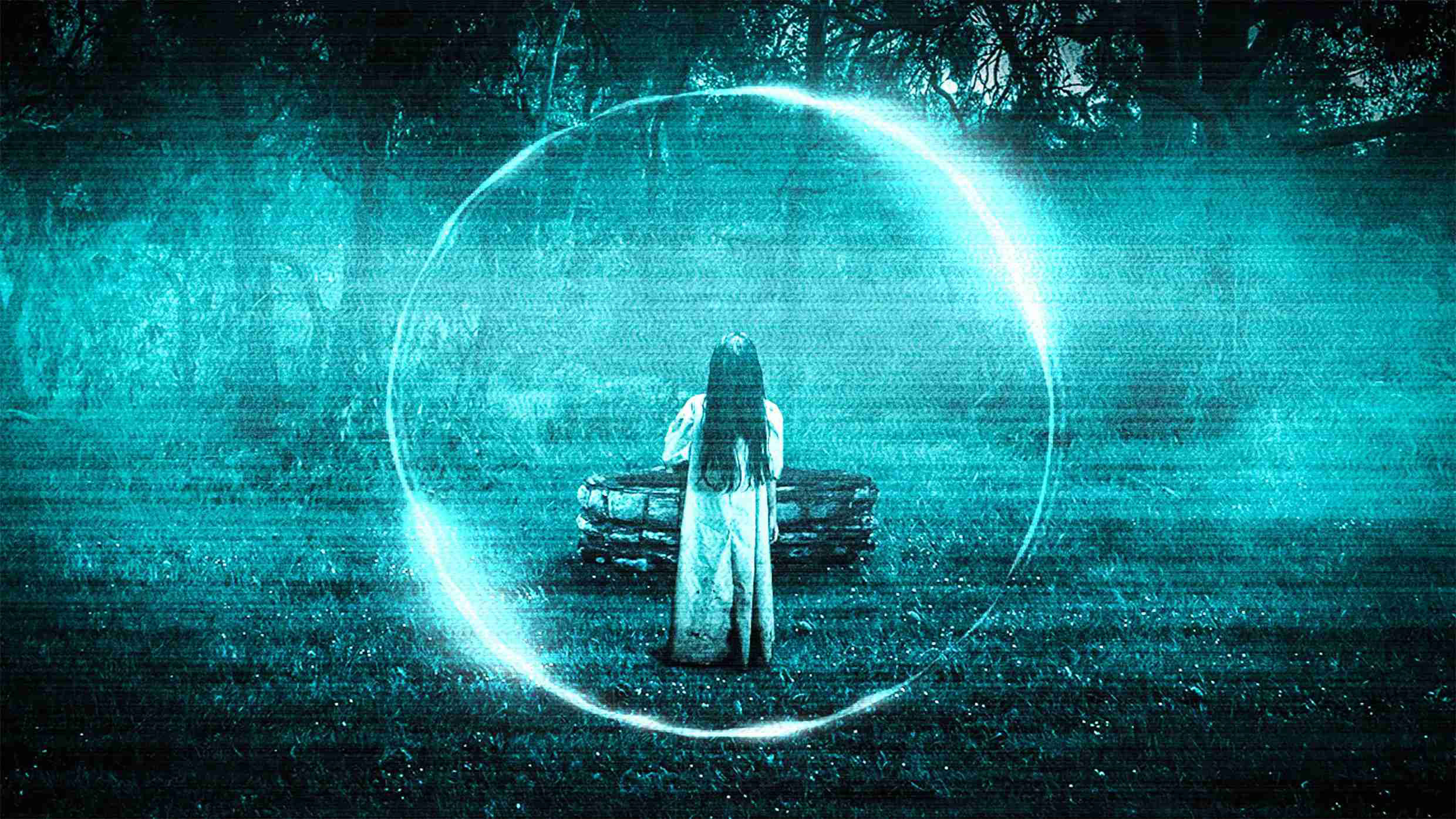
Photo credits: noset.com
Ikuma will try to kill the evil Sadako too, trowing her in a well and sealing it, but the entity survives the fall even if it is now imprisoned. Inside the well the demon will grow stronger and stronger until its hatred takes concrete form in the cursed video tape that in seven days leads to death whoever watches it.
But in spite of all this we can’t help but pity here, miserable soul. In her last moment of human lucidity, before her demoniac side takes over, she remembers of Toyama the only man she had ever loved.
The movies have a substantial differences from Koji Suzuki’s books regarding the story of this character as the young girl has an even more tormented and complicated life, ending with her fatal death.
Banchō Sarayashiki 番町皿屋敷

Photo credits: Wikipedia
The character created by Koji Suzuki, like many other of the Japanese modern horror genre, takes a cue from an old legend.
We are speaking about the story of Okiku and the nine plates. The Kabuki theater has often used this legend for its representations and there are many versions of it.
The protagonist is always Okiku a young and beautiful servant that works for the family of a samurai, Aoyama Tessan, that is in love with her. Countless times the girl refuses the samurai’s approaches, so to induce her in temptation he makes her believe she had lost a precious porcelain plate part of a set of ten. The poor girl desperately cries because she knows that the punishment will be severe, but the samurai comforts her saying that in exchange for her love she won’t be punished. Okiku still refuses him and the samurai blinded by rage pushes the girl into a well killing her.
Okiku comes back as a ghost to torment her assassin and keeps counting to nine and then start crying. Only a monk and exorcist is able to purify her spirit during one of her appearance. After he had her count to 9 the monk screams TEN!,in this way the spirit is free and ready to go to heaven.
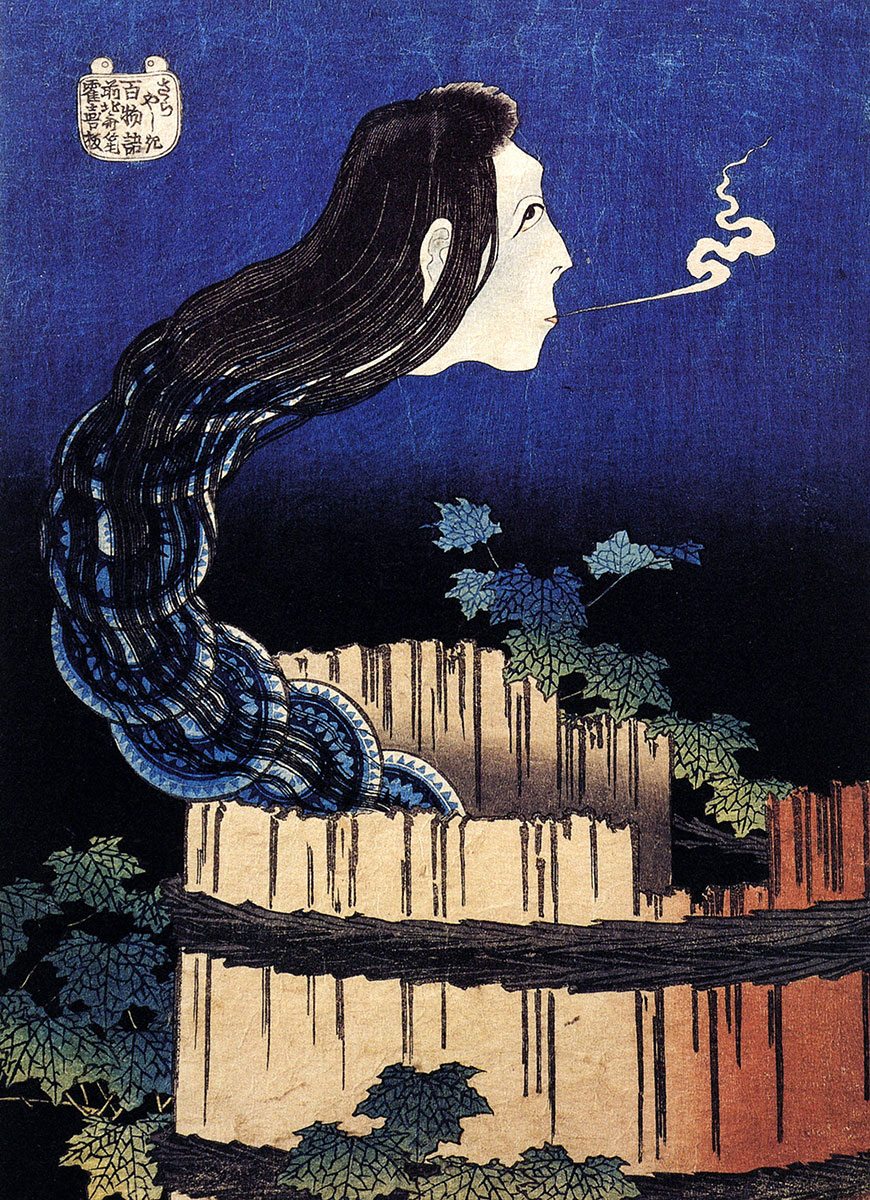
Photo credits: Wikipedia
As we said, there are many variations to this story, more or less similar to each other. In one of them the story takes place in the Himeji castle where Okiku dies because of a conspiracy within the court, or because the shogun, her lover, kills her because she voluntarily breaks the tenth plate.
Anyway, in every version we are brought to pity this character, surely obscure but tormented at the same time.
Japanese Tradition: Oiran
Oiran
Courtesans that led fashion
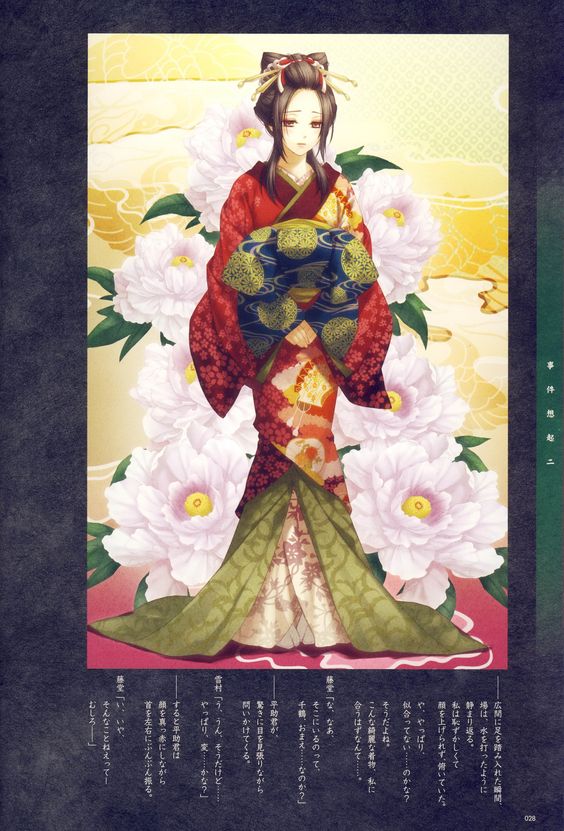
photo credit: pinterest
In ancient Japan ‘women of pleasure’ were called Yūjo (遊女). This word identified their job and also marked the difference between common prostitutes and courtesans, also called Oiran (花魁). The figure of the Oiran is the one we will analyze in this article.
The word Oiran derives from the sentence ‘oira no tokoro no nēsan’ (おいらの所の姉さん) that means ‘My older sister’. However, the literal translation would also be ‘The leader of all flowers’ since it is written with the kanji of 花 (Hana) “flower” and the kanji of 魁 (Sakikage) “leader”. At first, the word referred to high-class prostitutes of the Yoshiwara district (吉原) in Edo, today’s Tokyo. But later it was used in reference to courtesans.
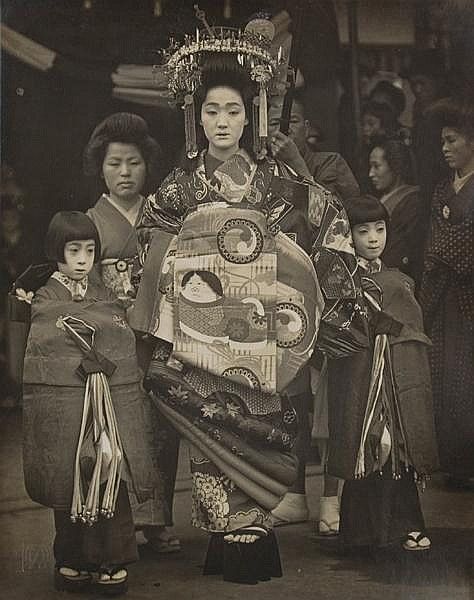
photo credit: pinterest
Oirans carried out their activities during the Edo period in pleasure districts called Yūkaku (that is not to be confused with the Hanamachi were only Geishas lived) . This districts were built outside the city center of Kyoto, Osaka and Edo, and were the only places were prostitution was legalized.
Unlike Yūjos, that sold their sexual favors, Oirans entertained their clients non only with their body but also with their abilities. These included the Sadō or the Tea ceremony, the Ikebana or the art of arranging flowers, being able to play different instruments, reading and having a good general knowledge. In fact, they had to be able to entertain the client also with their brilliant conversation skills.
The highest rank was that of the Tayū (太夫) that had the privilege to refuse a client if they wanted to. They were followed by Kōshi (格子). Their clients were part of the elite of the society like Daimyōs and rich feudal lords, and this was because the fee for a Oiran was very high. Just think that one night with an Oiran was equivalent to a whole year of a worker’s salary. To be able to meet one of them, clients had to be invited by the Oiran herself and had to enter a waiting list even weeks long.
The last official Oiran lived until 1761. The increasing popularity of Geishas made the request for Oirans decline. Nowadays this profession is not carried out anymore, if not with the meaning of preserving traditions and customs.
The most fascinating thing about Oirans is that due to the isolation they were forced into by the anti-prostitution law (prostitutes were to live in peripheral areas only) they were also idolized and mystified. They also led fashion and customs. They had the most peculiar hair-styles and the most rich and fancy kimonos with Getas (Japanese traditional shoes) fifteen cm high.
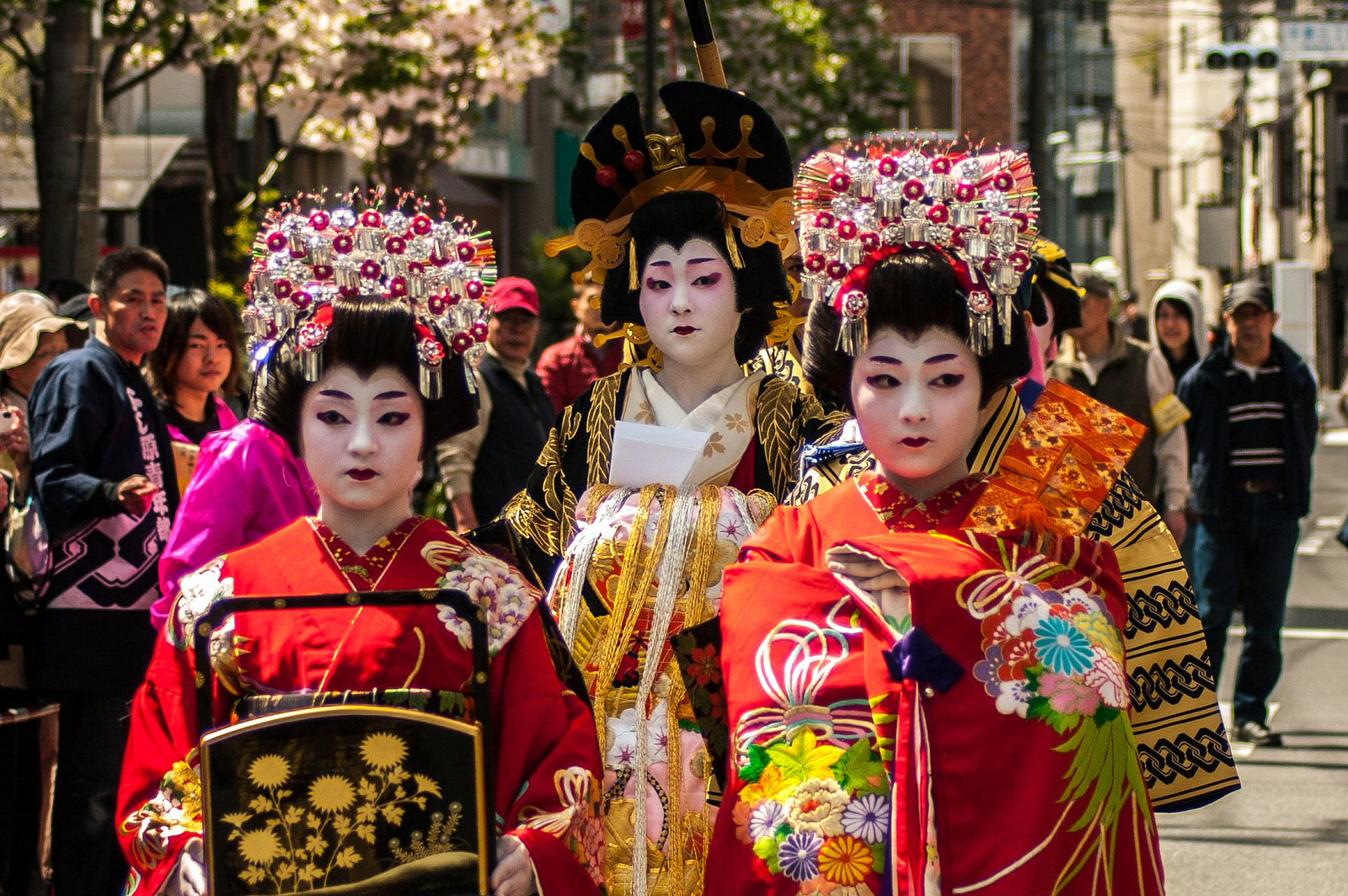
photo credit: tokyocheapo.com
Shinano, Sakura e Bunsui.
There are many events that celebrate these women during the year.
The first one, that takes place in April in the city of Tsubame, Hokuriku region, is the Bunsui Sakura Matsuri Oiran Dōchū. It is a parade famous throughout Japan were girls from different regions parade along the streets in order to obtain the role of one of the three leading Oirans : Shinano, Sakura and Bunsui. These names derive from the flowers of three different types of cherry trees. The girls parade ahead of a minimum of seventy different accompanying figures like Kamuros, their helpers, servants and concubines too. Each figure is selected every year with utmost care.
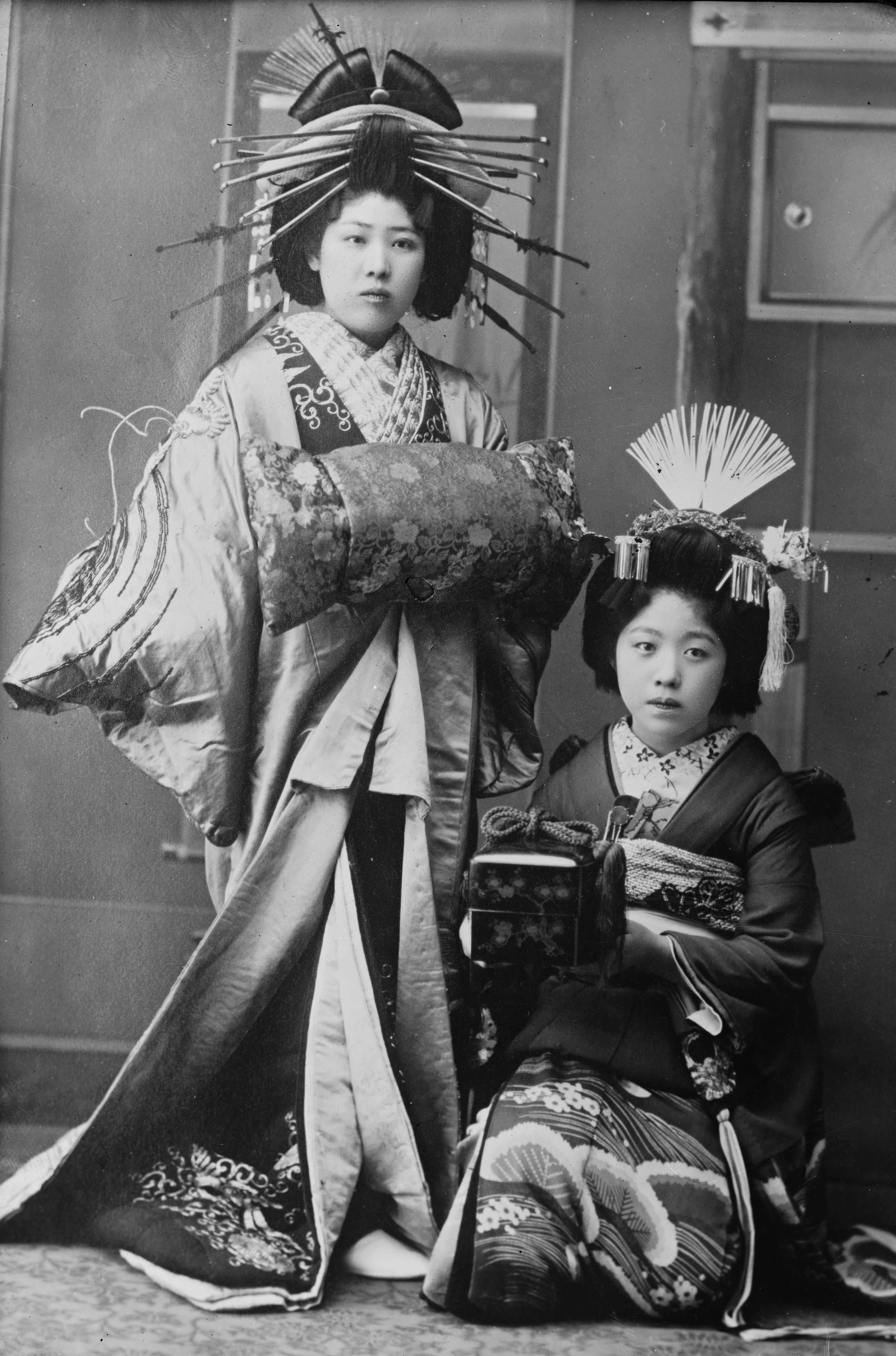
photo credit: wikipedia
In September in Shinagawa there is the Oiran Dōchū parade, and every early October in Nagoya, around the Ōsu Kannon temple, there’s the Ōsu Street Performers Festival were thousands of spectators can attend a two-days parade. Here Oirans walk down the shopping galleries of the Ōsu Kannon district with their whole entourage. Part of this entourage is the Yojimbo, similar to samurai but that actually has the role of a bodyguard, and there are apprentices too.
Charming, sensual and mysterious, like everything is in Japan, women of thousands faces and talents, beauty of an ancient time.
Japan Italy Bridge Tips: Edogawa Fireworks
Edogawa Fireworks

photo credit: ajpscs
If you are in Tokyo this summer we suggest this wonderful event that for 42 years has been entertaining people of Edogawa (Special ward of Tokyo that takes it’s name from Edo River).
The Edogawa Fireworks Festival takes place every first Saturday of August, where for 75 minutes you won’t be able to take your eyes from the sky. A show with more than 14,000 fireworks shot up into Tokyo’s sky.
We suggest you watch the show Shinozaki Park, about 15 minutes on foot from Shinozaki Station. Obviously it is a free event but hurry up if you want to catch the perfect spot! Right in time to be amazed by the spectacular opening with about 1000 golden and silver fireworks shot up into the sky only during the first incredible minutes.
If you are not sure to catch a spot then you can reserve one buying your thicket on this site (Japanese only).
Whether you go alone, or with your lover, whether you are with your friends or your family… Don’t miss this unique event!!
DATE: 5th Aug, 2017
STARTING/FINISHING TIME: 07:15pm – 08:30pm
LOCATION: Edogawa Fireworks Festival Location
ENTRY: Free / Reservable seats here (Japanese only)
CLOSER STATION: Shinozaki
WHERE: Ichikawa, Tokyo

photo credit: cate♪

photo credit: Luke Kaneko
Japanese Culture: Geisha & Maiko
Maiko and Geisha: Dancing Artists
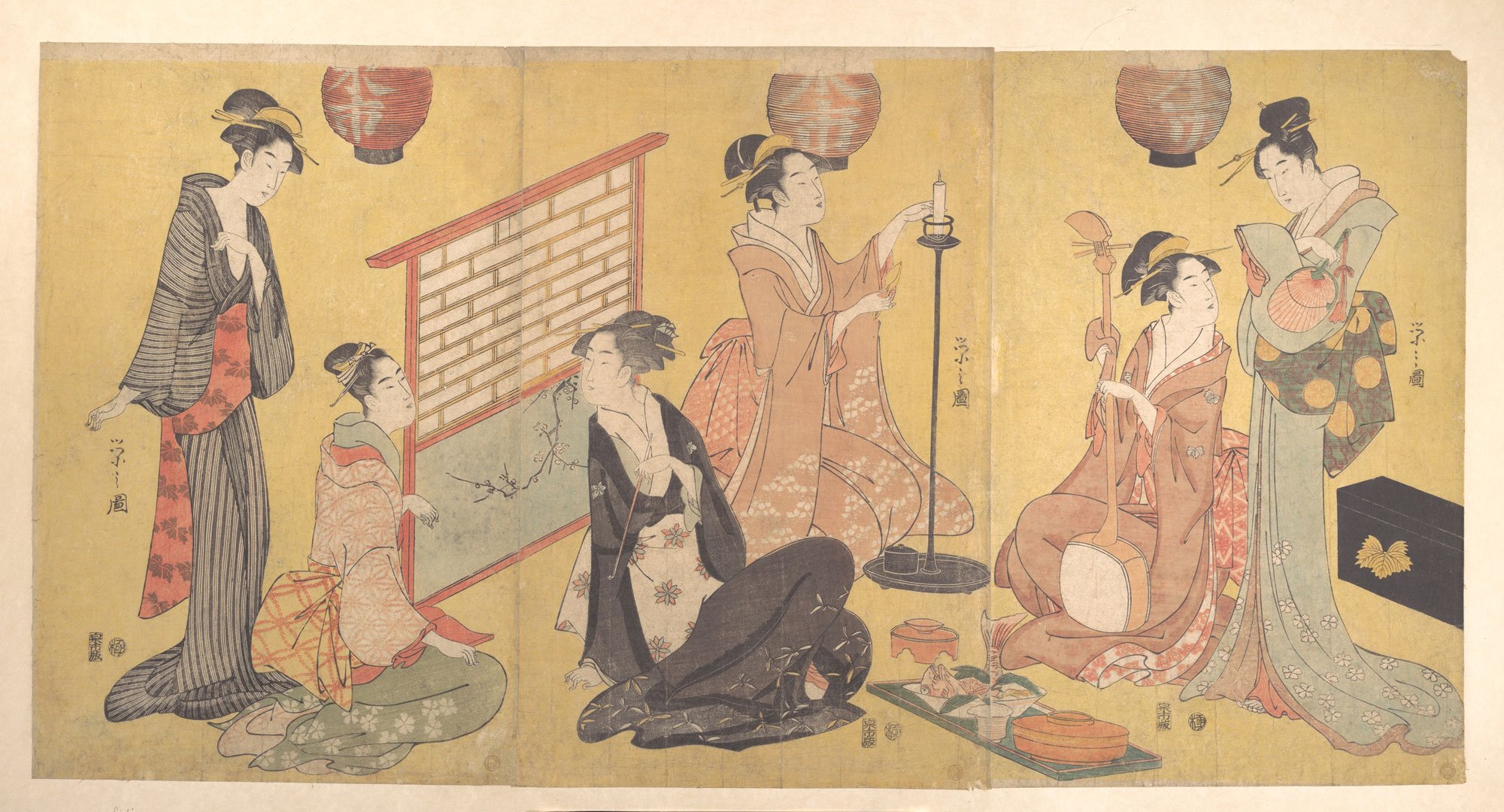
photo credit: metmuseum.org
The most representative and mysterious artistic figure of the 'Country of the rising sun' is the Geisha (芸者 "Person who embodies art").
She is often confused with the Maiko (舞妓 "Dancing girl") that is the apprentice and aspiring geisha. To become a geisha is required a long period of apprenticeship in dedicated schools. Here girls learn how to dance, sing and the use of the Shamisen (三味線 "Three strings" typical musical instrument). Regarding the skills of entertaining costumers, the maiko learns everything following a geisha around the many tea houses. The relationship between maiko and geisha is like a real ‘Sisterhood’. The two of them respectively call each other imoto-san or “younger sister”, and onee-san “big sister". The bound between them is so strong that the stage name of the future geisha is chosen by her big sister, and the maiko will carry that name for all her artistic career.

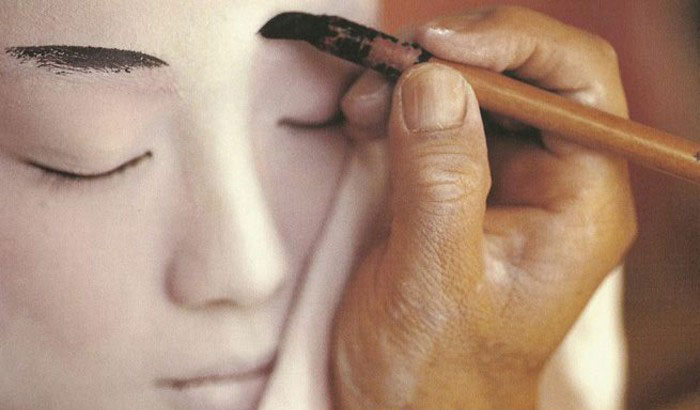
photo credit: freshdesignpedia.com
The bright colors of their kimonos will become darker as the geisha becomes older. The Nihongami, the typical hair-style of the Edo period, is very intricate and difficult both to realize and to maintain. It is usually embellished with the Kanzashi, decorative hair ornaments that would vary depending on the season (for example flowers in spring, doves for the New Year). The kanzashi too will become simpler over time, and the excessive make-up, with its typical small carmine lips standing out on a snow-white face, will be substituted with a different one for a more natural effect.
The little habit of exposing the neck (in the Japanese culture the neck is the most sensual part of a woman) will add another painted white line to the two lines previously used.
In the past the daughters of geishas would start on this path at a young age. Nowadays it is more common to start the apprenticeship after completing university studies. Nevertheless, this is a career started out of their free will and not in order to continue a family tradition. It must be said that this community made of women, with their strict traditions and strong moral ethics, is determined to keep its centuries-old secret.
“The art of being a woman”

photo credit: Pinterest
Usually, in the common imagery, geishas are women full of charm but submissive, devoted to their man and their every little whim. However this is a mistake since in the past they were the first women in the Japanese society with full autonomy.
Everything started from the Taikomochis (太鼓持), jesters that entertained the Shōgun (将軍 "commander of the army") and his Daimyō (大名) the nobility, with acrobatic exercises and jokes.
In spite of the Taikomochis being really appreciated for their carefree spirit, this figure came to slowly disappear with the appearance of the first geishas. Obviously the created a sensation and they were soon preferred to taikomochis for their sensual movements and feminine gracefulness.
But these women were not courtesans nor prostitutes. Prostitutes were identified as Oirans (花魁). Geishas were artists highly requested. Theirs skills included dancing, singing and music in general. They also had to be good conversationalist and entertainer. They would perform their profession in the Okiya (置屋) or “Geisha houses” in Kyoto, the capital of the Empire at that time. During the second half of ‘800 the isolation of Japan, that had lasted for about two-hundred years, came to an end. This was the exact moment when Europe came in contact with a new exotic harbor.
With this, the whole world came to know the figure of the geisha and her charm. And they would influence the occidental style and costumes too. Puccini composed the moving Madame Butterfly, and in the field of the pictorial arts they became muses for well-know painter of the time. Manet, Monet, Klimt, Renoir and Van Gogh are just some of the artists that tried to take their inspiration from this so-called Nipponism. This artistic movement was a tribute to the art of the Ukiyo-e (浮世絵 "picture of the floating world). And not only this, we find geishas in the prints of Katsushika Hokusa (The Great Wave off Kanagawa) and Kitagawa Utamaro. Utamaro in particular became famous for his prints dedicated to women. The more this artistic movement grew in Japan, the more the ukiyo-e prints became famous all over the world too, and the demand for it equally increased.
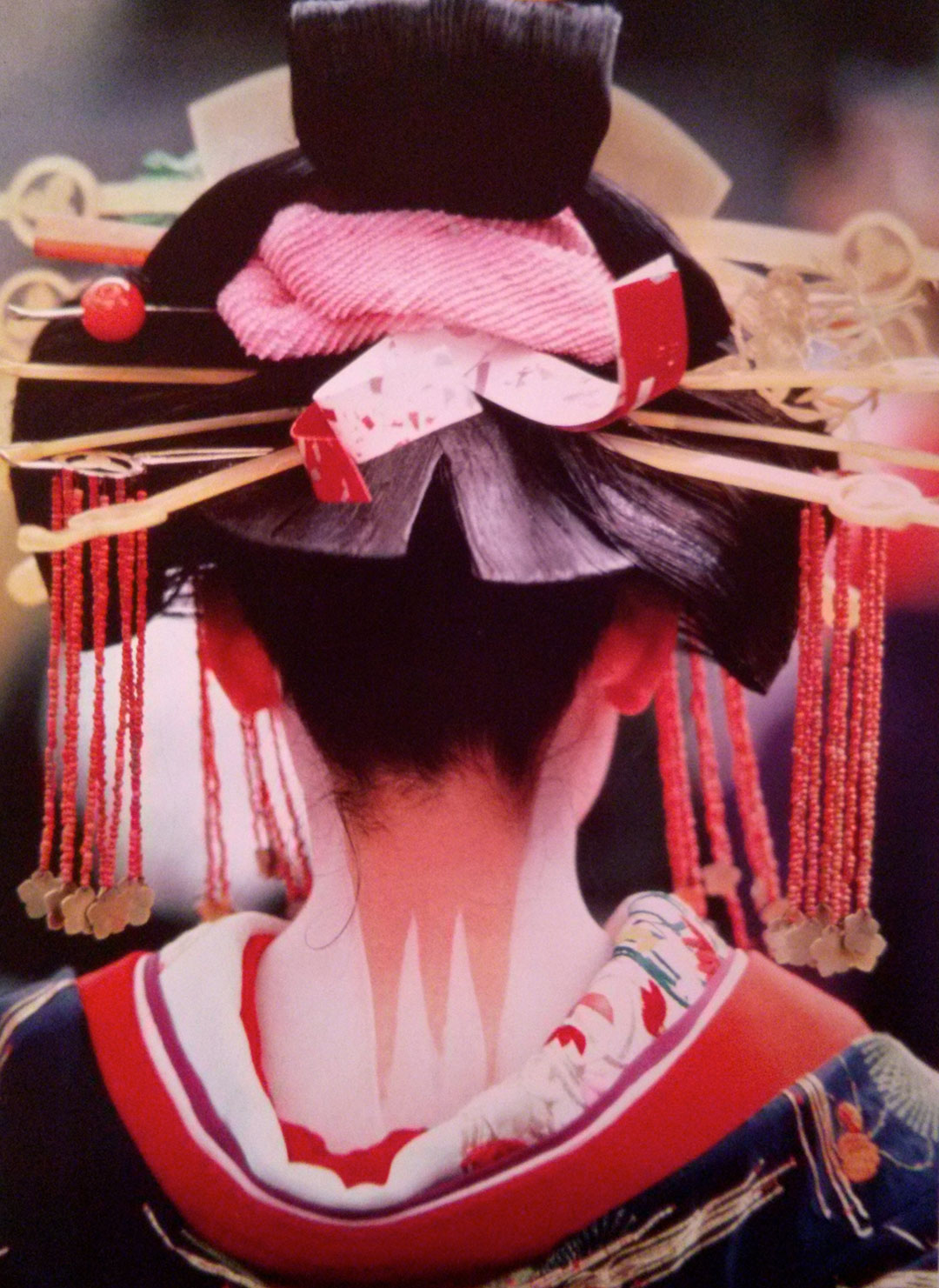
photo credit: makeuppix.com
“Wives of nightfall”
During the Second World War with the arrival of American soldiers the figure of the geisha was distorted. They were given the role of prostitutes because the young girls comforting the soldiers were called “geisha girls”. This produced an anti-feminist and erroneous idea of this women.
It was really difficult for the geishas to focus on love because of the strict rules required in this profession. They could have as sole companion their Danna (旦那). In Japanese “danna” means master and he was the closest thing to a husband for them. He would take care of his protege financially supporting her performances, and sometimes extinguishing the debt that she had with the okiya for her instruction. Usually it was the danna that would chose his geisha, not the contrary. Nevertheless it was not rare for them to fall in love.
Luckily times have changed. Today geishas can freely fall in love with the person they want, but obviously they will put an end to their activities after marriage. It is common for ex geishas to become dance teachers.
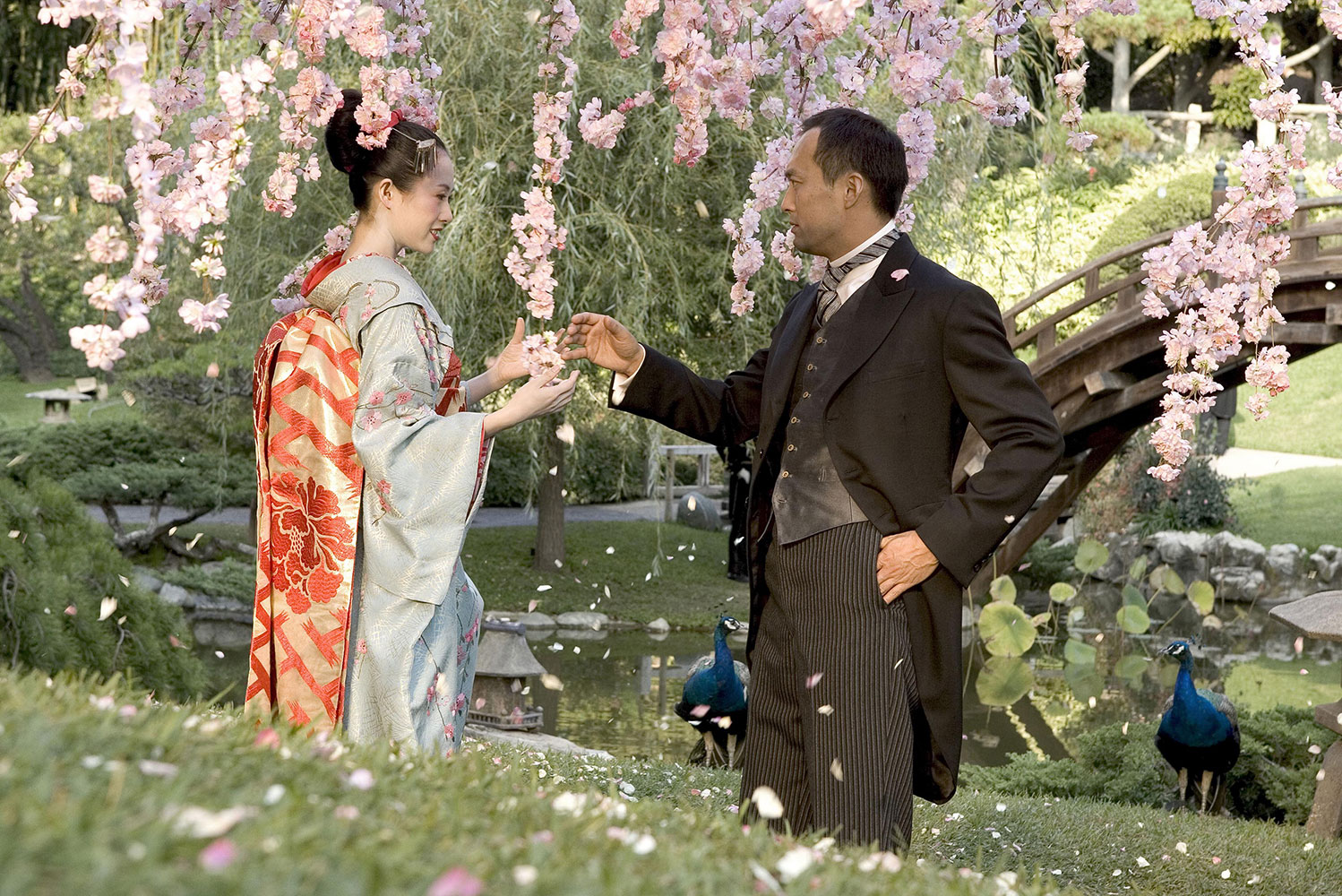
still from the movie "Memoirs of a Geisha"
The number of geishas is strongly decreasing and it is a profession kept alive mostly for touristic purpose. In fact, their audience is not made by men only, but women appreciate them too.
I would like here to report the marvelous words of Arthur Golden that with his best seller “Memories of a Geisha” created a beautiful picture of this figure. He allowed us to rediscover this parallel universe half-way between the past and the modernity.
“Geisha is an artist of the floating world. She dances. She sings. She entertains you. Whatever you want. The rest is shadows. The rest is secret.”
Japanese Folklore: Kappa
Kappa or “Son of the river”
A Kappa is a funny chimera, its true appearance is still unknown, a bit human a bit monkey-like. But most of the times it is depicted with the face of a tortoise with a yellow beak. From tortoises it borrowed the shell and the scaly skin with its watery colors, usually of a nice seaweed-green. On the head it carries a lotus leaf containing water, and it is from this water that it draws its powers. This is the Kappa (河童) or, if you like, you could call it Kawatarō ( "boy of the river") or Kawako ("son of the river"), you will make him happy.
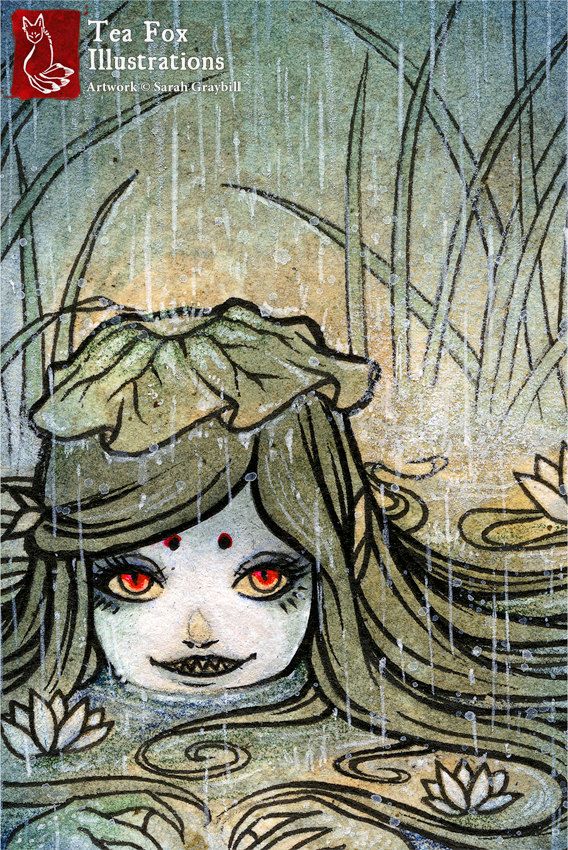
Born as a warning to scare kids away from the dangers lurking into deep waters, they are Shintoist Suijin (水神 "water god"). However, generally speaking these mythological figures are one of the many Yōkai (demons or phantoms) of the Nipponic folklore.
As much as its appearance may arouse your mockery, the Kappa is not the type to make fun of because it is a mischievous and naughty creature. In the past it was said that he abducted children because it is a glutton for them, but didn’t say no to adults bowels. They are always ready to do mischievous pranks from pulling the kimono of young girls to stealing the harvest of farmers.

Even if it is naughty and somewhat dangerous, formalities are a good way to be safe with it. That’s right, it is a very polite creature even if it seems hard to believe. The Kappa loves good manners and if you make him do a good, deep bow, it will spill its magical water and lose all its powers. The Kappa is also a creature always ready to stick to its word and to give rewards. If you find a Kappa in difficulty help it by pouring water on the leaf on its head, it will be indebted to you for life! Maybe you would like to have one of them as a friend? Well, I said nothing but Kappa love cucumbers! Yes! Offer this fresh vegetables to a Kappa and it will reward you with its friendship. And well, who wouldn’t like to have one as a friend nowadays?
Usually, they live in lakes and deep ponds and this is why they are skilled swimmers. But here we must say “kappa no kawa nagare”, "a kappa drowing in a river" , because even the most skilled make mistakes, so never give up!
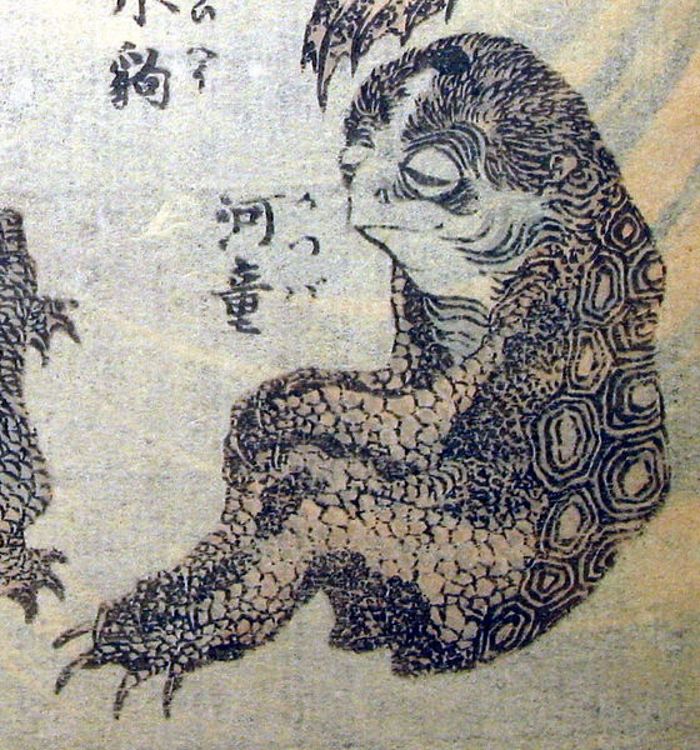
Nowadays they are not as feared as in the past, they have become somewhat more “Kawaii” and a great number of animes take a cue from them. In Marmalade Boy the two main characters Miki and Yu have a Kappa plush as their mascot; different Pokemons were inspired to this creature and Kappa no Coo to Natsuyasumi (Summer days with Coo) is the story of the friendship between a kid of our days and a Kappa looking for its fellows.
Even J.K. Rowlong wrote about this mythological creature in her book Fantastic beasts: where to find them. And if you are interested in seeing a real one, or at least what is left of it, you would like to go to Asakusa, Tokyo district. In the Buddhist temple Sogen-ji you can worship its remains.
photo credit: manganews, wikipedia, facebook.com/TeaFoxIllustrations











